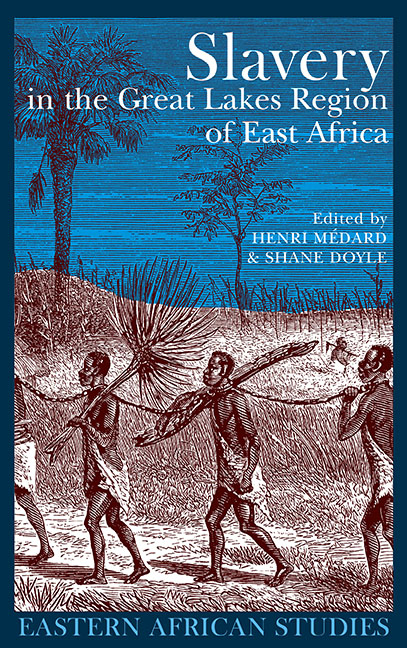Book contents
- Frontmatter
- Dedication
- Contents
- List of Maps & Tables
- Notes on Contributors
- Introduction
- 1 Violence, Marginality, Scorn & Honour: Language evidence of slavery to the eighteenth century
- 2 Notes on the Rise of Slavery & Social Change in Unyamwezi c. 1860 –1900
- 3 Slavery & Forced Labour in the Eastern Congo 1850 –1910
- 4 Legacies of Slavery in North West Uganda: The story of the ‘One-Elevens’
- 5 Human Booty in Buganda: Some observations on the seizure of people in war c.1700 –1890
- 6 Stolen People & Autonomous Chiefs in Nineteenth-Century Buganda: The social consequences of non-free followers
- 7 Women's Experiences of Enslavement & Slavery in Late Nineteenth- & Early Twentieth-Century Uganda
- 8 Slavery & Other Forms of Social Oppression in Ankole 1890 –1940
- 9 The Slave Trade in Burundi & Rwanda at the Beginning of German Colonisation 1890 –1906
- 10 Bunyoro & the Demography of Slavery Debate: Fertility, kinship & assimilation
- References
- Index
3 - Slavery & Forced Labour in the Eastern Congo 1850 –1910
Published online by Cambridge University Press: 11 August 2017
- Frontmatter
- Dedication
- Contents
- List of Maps & Tables
- Notes on Contributors
- Introduction
- 1 Violence, Marginality, Scorn & Honour: Language evidence of slavery to the eighteenth century
- 2 Notes on the Rise of Slavery & Social Change in Unyamwezi c. 1860 –1900
- 3 Slavery & Forced Labour in the Eastern Congo 1850 –1910
- 4 Legacies of Slavery in North West Uganda: The story of the ‘One-Elevens’
- 5 Human Booty in Buganda: Some observations on the seizure of people in war c.1700 –1890
- 6 Stolen People & Autonomous Chiefs in Nineteenth-Century Buganda: The social consequences of non-free followers
- 7 Women's Experiences of Enslavement & Slavery in Late Nineteenth- & Early Twentieth-Century Uganda
- 8 Slavery & Other Forms of Social Oppression in Ankole 1890 –1940
- 9 The Slave Trade in Burundi & Rwanda at the Beginning of German Colonisation 1890 –1906
- 10 Bunyoro & the Demography of Slavery Debate: Fertility, kinship & assimilation
- References
- Index
Summary
Introduction
From the mid-nineteenth century, outside forces transformed the once isolated eastern Congo. Zanzibari traders established a commercial empire there in the 1870s. The new Congo Free State of King Leopold II of Belgium then absorbed the region by legal annexation in 1887, initially making the Zanzibari leader Tippu Tip its governor, before formalising its control through military conquest in 1892–94. In the first third of the twentieth century the territory formed the Congo's populous and productive Province Orientale.
Besides their political and economic impacts, each of these regimes substantially affected labour relations. The Zanzibari rulers markedly increased enslavement for labour purposes. Although the European regimes were pledged to ending slavery, their efforts to command the resources of the region employed forced labour on a large scale. To understand the dynamics of slavery in the eastern Congo one needs to respect the complexity and fluidity of these circumstances and of the perspectives of the participants. As researchers have stressed, slavery in Africa was a range of subordinate institutions, whose particular traits changed with historical conditions. Moreover, the line between free and unfree labour was also shifting in Western minds during the course of the nineteenth and twentieth centuries.
Pre-colonisation
Gender and social status largely defined the division of labour that existed in eastern Congo on the eve of colonisation. The fundamental separation of tasks into men's and women's work was strictly adhered to, at least among free persons. A large share of the ordinary work of farming fell upon women, as did a considerable share of the carrying tasks, from babies to bananas. Crafts, such as the making of cloth, pottery and baskets, also generally came under the heading of women's work. Men hunted, fished, herded cattle, cleared land for farming, smelted and smithed, and went to war.
Social status varied much more than gender roles in the region. The region's isolation, low population densities, and limited economic development inhibited the formation of a slave population in most areas, although degrees of servitude may have existed among some riverain populations such as the Wagenia, a fisherfolk on the upper Congo, and among the Yalusuna agriculturalists west of Kisangani.
- Type
- Chapter
- Information
- Slavery in the Great Lakes Region of East Africa , pp. 111 - 123Publisher: Boydell & BrewerPrint publication year: 2007

